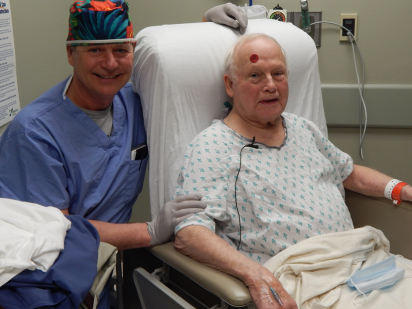Older adults may recall a time when cataract surgery meant a hospital stay and having to wear “coke bottle” glasses. The super-thick lenses were the only means of bringing one’s world into focus after a natural lens was removed.
Today, intraocular lenses (IOLs) and other technological advancements have revolutionized cataract surgery. The outpatient procedure is now one of the most common surgeries in the world and successful, offering patients a 98% chance of regaining much-improved vision.
A cataract is a clouding of the eye’s lens, which blocks or changes the passage of light into the eye. The American Academy of Ophthalmology lists blurred vision and trouble seeing well at night as typical symptoms. Other patients report double vision and sensitivity to light.
Cataracts are the world’s leading cause of blindness, accounting for approximately 42% of all cases of blindness worldwide. In the US, more than 25 million Americans are estimated to have cataracts. While cataract often develops with age, it can occur at any point in life.
Center of Excellence
A welcoming team of skilled, compassionate providers, together with the most up-to-date technology, Trinity Regional Eyecare – Minot and Trinity Health Western Dakota in Williston have a well-earned reputation for delivering cutting-edge eyecare services.
Ophthalmologists Darren Hill, MD, Evelyne Kindy, MD, Mark Raymond, MD, Jewel Sandy, MD, Darrell Williams, MD, and Chad Wolsky, MD, employ the latest techniques to remove the cloudy lenses of cataract patients and replace them with intraocular lens implants.
Vision for the Visionary
Recently, TRE-Minot was honored to serve North Dakota native and inventor Bill Isaacson, who developed the first bifocal or multifocal intraocular lens in 1987. The Stanley, N.D., resident underwent cataract lens implant surgery at the hand of ophthalmologist Darrell Williams, MD.“It is remarkable that Bill Isaacson will benefit from his own invention,” Dr. Williams stated. “He has helped patients worldwide to achieve their dreams with better vison. His multifocal design is the major innovation in IOL optics technology since the invention of the original monofocal lens in the 1940s.”
Isaacson received a trifocal lens, which Trinity Health ophthalmologists have incorporated into their practices as one of several lens options. It’s an updated version of Isaacson’s original lens. “There are now multifocal lenses approved by the FDA allowing for three (trifocal) ranges of focused vision. It is an evolution of the technology employed with my original invention using diffraction optics in order to see near and distant objects with less dependence on glasses after surgery,” he said.
Improving Lives, Starting with Mom
A Minot native, Isaacson graduated from Minot High in 1956 and enrolled at Minot State University. The Soviet Union had just launched Sputnik, so scientists and engineers were urgently needed. Isaacson attended MSU for pre-engineering but developed an interest in petroleum refinery. He completed both his bachelor’s degree and PhD in chemical engineering at Montana State University, Bozeman.
After graduation, Isaacson’s quest was to design products that would improve lives through vision technology. He found the opportunity to pursue that mission at 3M in St. Paul, MN, which he joined in 1963. A scientist with a keen mind and a gift for invention, Isaacson served as a venture director in 3M’s life sciences sector and was regarded as “corporate intrapreneur.” The environment allowed him to design such innovations as extended wear contact lenses, multifocal contact lenses, artificial corneas, surgical glue and the world’s first multifocal intraocular lens.
Dr. Williams was an investigator for the 3M company to evaluate Isaacson’s original multifocal design. He used the device during cataract surgery for Isaacson’s mother, Helen, in 1989, which brought great joy to the inventor.
“Of all the ventures I have pursued the one that has brought me the greatest satisfaction was being able to improve the quality of life for my mother during the last five years of her life,” Isaacson said. “She had cataracts that left her with very poor vision; her life was going downhill. That lens changed her life. She took up watercolor painting again. It gave her hope.”
For more information about cataracts or to make an appointment, call Trinity Regional Eyecare – Minot at 701-857-3500 or Trinity Health Western Dakota, Williston, at 701-572-7641.
Prevent Blindness, an organization dedicated to preserving eyesight, has declared June as Cataract Awareness Month.
Risk factors for cataracts:
• Older age
• Intense heat or long-term exposure to UV rays from the sun
• Eye diseases such as diabetes
• Hereditary factors
• Long-term steroid use
• Eye injuries
• Smoking

